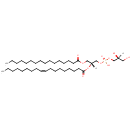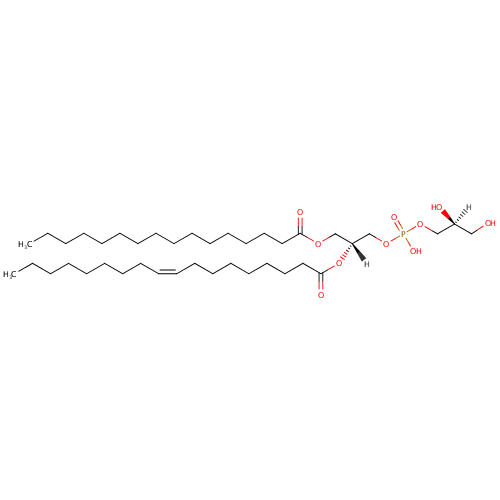
PG(18:1(9Z)/16:0) (PAMDB006251)
| Record Information | |||||||||||||||||||||||||||||||||||||||||||||||||||||||||||||
|---|---|---|---|---|---|---|---|---|---|---|---|---|---|---|---|---|---|---|---|---|---|---|---|---|---|---|---|---|---|---|---|---|---|---|---|---|---|---|---|---|---|---|---|---|---|---|---|---|---|---|---|---|---|---|---|---|---|---|---|---|---|
| Version | 1.0 | ||||||||||||||||||||||||||||||||||||||||||||||||||||||||||||
| Update Date | 1/22/2018 11:54:54 AM | ||||||||||||||||||||||||||||||||||||||||||||||||||||||||||||
| Metabolite ID | PAMDB006251 | ||||||||||||||||||||||||||||||||||||||||||||||||||||||||||||
| Identification | |||||||||||||||||||||||||||||||||||||||||||||||||||||||||||||
| Name: | PG(18:1(9Z)/16:0) | ||||||||||||||||||||||||||||||||||||||||||||||||||||||||||||
| Description: | PG(18:1(9Z)/16:0) is a phosphatidylglycerol. Phosphatidylglycerols consist of a glycerol 3-phosphate backbone esterified to either saturated or unsaturated fatty acids on carbons 1 and 2. As is the case with diacylglycerols, phosphatidylglycerols can have many different combinations of fatty acids of varying lengths and saturation attached to the C-1 and C-2 positions. PG(18:1(9Z)/16:0), in particular, consists of one 9Z-octadecenoyl chain to the C-1 atom, and one hexadecanoyl to the C-2 atom. In Pseudomonas aeruginosa glycerophospholipid metabolism, phosphatidylglycerol is formed from phosphatidic acid (1,2-diacyl-sn-glycerol 3-phosphate) by a sequence of enzymatic reactions that proceeds via two intermediates, cytidine diphosphate diacylglycerol (CDP-diacylglycerol) and phosphatidylglycerophosphate (PGP, a phosphorylated phosphatidylglycerol). Phosphatidylglycerols, along with CDP-diacylglycerol, also serve as precursor molecules for the synthesis of cardiolipin, a phospholipid found in membranes. | ||||||||||||||||||||||||||||||||||||||||||||||||||||||||||||
| Structure | |||||||||||||||||||||||||||||||||||||||||||||||||||||||||||||
| Synonyms: | Not Available | ||||||||||||||||||||||||||||||||||||||||||||||||||||||||||||
| Chemical Formula: | C40H77O10P | ||||||||||||||||||||||||||||||||||||||||||||||||||||||||||||
| Average Molecular Weight: | 749.0071 | ||||||||||||||||||||||||||||||||||||||||||||||||||||||||||||
| Monoisotopic Molecular Weight: | 748.525435196 | ||||||||||||||||||||||||||||||||||||||||||||||||||||||||||||
| InChI Key: | PAZGBAOHGQRCBP-HGWHEPCSSA-N | ||||||||||||||||||||||||||||||||||||||||||||||||||||||||||||
| InChI: | InChI=1S/C40H77O10P/c1-3-5-7-9-11-13-15-17-18-20-22-24-26-28-30-32-40(44)50-38(36-49-51(45,46)48-34-37(42)33-41)35-47-39(43)31-29-27-25-23-21-19-16-14-12-10-8-6-4-2/h17-18,37-38,41-42H,3-16,19-36H2,1-2H3,(H,45,46)/b18-17-/t37-,38+/m0/s1 | ||||||||||||||||||||||||||||||||||||||||||||||||||||||||||||
| CAS number: | Not Available | ||||||||||||||||||||||||||||||||||||||||||||||||||||||||||||
| IUPAC Name: | [(2S)-2,3-dihydroxypropoxy][(2R)-3-(hexadecanoyloxy)-2-[(9Z)-octadec-9-enoyloxy]propoxy]phosphinic acid | ||||||||||||||||||||||||||||||||||||||||||||||||||||||||||||
| Traditional IUPAC Name: | (2S)-2,3-dihydroxypropoxy(2R)-3-(hexadecanoyloxy)-2-[(9Z)-octadec-9-enoyloxy]propoxyphosphinic acid | ||||||||||||||||||||||||||||||||||||||||||||||||||||||||||||
| SMILES: | [H][C@](O)(CO)COP(O)(=O)OC[C@@]([H])(COC(=O)CCCCCCCCCCCCCCC)OC(=O)CCCCCCC\C=C/CCCCCCCC | ||||||||||||||||||||||||||||||||||||||||||||||||||||||||||||
| Chemical Taxonomy | |||||||||||||||||||||||||||||||||||||||||||||||||||||||||||||
| Taxonomy Description | This compound belongs to the class of organic compounds known as phosphatidylglycerols. These are glycerophosphoglycerols in which two fatty acids are bonded to the 1-glycerol moiety through ester linkages. | ||||||||||||||||||||||||||||||||||||||||||||||||||||||||||||
| Kingdom | Organic compounds | ||||||||||||||||||||||||||||||||||||||||||||||||||||||||||||
| Super Class | Lipids and lipid-like molecules | ||||||||||||||||||||||||||||||||||||||||||||||||||||||||||||
| Class | Glycerophospholipids | ||||||||||||||||||||||||||||||||||||||||||||||||||||||||||||
| Sub Class | Glycerophosphoglycerols | ||||||||||||||||||||||||||||||||||||||||||||||||||||||||||||
| Direct Parent | Phosphatidylglycerols | ||||||||||||||||||||||||||||||||||||||||||||||||||||||||||||
| Alternative Parents | |||||||||||||||||||||||||||||||||||||||||||||||||||||||||||||
| Substituents |
| ||||||||||||||||||||||||||||||||||||||||||||||||||||||||||||
| Molecular Framework | Aliphatic acyclic compounds | ||||||||||||||||||||||||||||||||||||||||||||||||||||||||||||
| External Descriptors |
| ||||||||||||||||||||||||||||||||||||||||||||||||||||||||||||
| Physical Properties | |||||||||||||||||||||||||||||||||||||||||||||||||||||||||||||
| State: | Not Available | ||||||||||||||||||||||||||||||||||||||||||||||||||||||||||||
| Charge: | -1 | ||||||||||||||||||||||||||||||||||||||||||||||||||||||||||||
| Melting point: | Not Available | ||||||||||||||||||||||||||||||||||||||||||||||||||||||||||||
| Experimental Properties: |
| ||||||||||||||||||||||||||||||||||||||||||||||||||||||||||||
| Predicted Properties |
| ||||||||||||||||||||||||||||||||||||||||||||||||||||||||||||
| Biological Properties | |||||||||||||||||||||||||||||||||||||||||||||||||||||||||||||
| Cellular Locations: | Membrane | ||||||||||||||||||||||||||||||||||||||||||||||||||||||||||||
| Reactions: | PGP(18:1(9Z)/16:0) + Water > PG(18:1(9Z)/16:0) + Phosphate PE(18:1(9Z)/16:1(9Z)) + PG(18:1(9Z)/16:0) > Ethanolamine + CL(18:1(9Z)/16:0/18:1(9Z)/16:1(9Z)) PE(18:1(9Z)/18:1(9Z)) + PG(18:1(9Z)/16:0) > Ethanolamine + CL(18:1(9Z)/16:0/18:1(9Z)/18:1(9Z)) PE(14:0/18:1(9Z)) + PG(18:1(9Z)/16:0) > Ethanolamine + CL(18:1(9Z)/16:0/14:0/18:1(9Z)) PG(18:1(9Z)/16:0) + PE(14:0/14:0) > Ethanolamine + CL(18:1(9Z)/16:0/14:0/14:0) PG(18:1(9Z)/16:0) + PE(14:0/16:0) > Ethanolamine + CL(18:1(9Z)/16:0/14:0/16:0) PG(18:1(9Z)/16:0) + PE(16:0/19:0cycw8c) > Ethanolamine + CL(18:1(9Z)/16:0/16:0/19:0cycv8c) PE(18:1(9Z)/14:0) + PG(18:1(9Z)/16:0) > Ethanolamine + CL(18:1(9Z)/16:0/18:1(9Z)/14:0) PG(18:1(9Z)/16:0) + PE(19:0cycv8c/19:iso) > Ethanolamine + CL(18:1(9Z)/16:0/19:0cycv8c/19:0cycv8c) PE(17:0cycw7c/17:0cycw7c) + PG(18:1(9Z)/16:0) > Ethanolamine + CL(18:1(9Z)/16:0/17:0cycw7c/17:0cycw7c) 2 PG(18:1(9Z)/16:0) > Glycerol + CL(18:1(9Z)/16:0/18:1(9Z)/16:0) | ||||||||||||||||||||||||||||||||||||||||||||||||||||||||||||
| Pathways: | Not Available | ||||||||||||||||||||||||||||||||||||||||||||||||||||||||||||
| Spectra | |||||||||||||||||||||||||||||||||||||||||||||||||||||||||||||
| Spectra: |
| ||||||||||||||||||||||||||||||||||||||||||||||||||||||||||||
| References | |||||||||||||||||||||||||||||||||||||||||||||||||||||||||||||
| References: |
| ||||||||||||||||||||||||||||||||||||||||||||||||||||||||||||
| Synthesis Reference: | Not Available | ||||||||||||||||||||||||||||||||||||||||||||||||||||||||||||
| Material Safety Data Sheet (MSDS) | Not Available | ||||||||||||||||||||||||||||||||||||||||||||||||||||||||||||
| Links | |||||||||||||||||||||||||||||||||||||||||||||||||||||||||||||
| External Links: |
| ||||||||||||||||||||||||||||||||||||||||||||||||||||||||||||

